At a time in history when most people’s attention is focused on the historical and celebratory significance of monuments, perhaps the aesthetic one escapes instead: and in Italy, the country that everyone pompously celebrates as the land of “beauty,” in reality hideous monuments are everywhere. So, are these ugliness that dot our country works whose ugliness is nevertheless an aesthetic category worthy of preservation (as perhaps Asger Jorn would like, because in any case, ugliness moves our passions and does not leave us indifferent), or are they simply obscurities that disfigure streets and squares, and for which some might even hope that they will be torn down in an iconoclastic access of any groups of haters of the horrid? While we wait to unravel the question, we offer here a roundup of ugly monuments to underscore how we sometimes forget that we are the country that gave birth to Michelangelo, Bernini and Canova, and that we are actually a country where local administrators who have never developed a sense of beauty rage.
1. Monument to Manuela Arcuri (Porto Cesareo, Lecce).
It has never been understood why the Salento municipality of Porto Cesareo wanted to dedicate a monument to Manuela Arcuri, who is from Lazio. The only thing certain is that the plaque reads, “symbol of beauty and prosperity.” With a détournement that would have made Guy Debord envious, this beauty is, however, rendered with a monument that will only be beautiful the moment they tear it down: the poor showgirl strides awkwardly with an improbable cornucopia from which two melons seem to emerge (which are actually Arcuri’s breasts, exaggeratedly swollen by the sculptor in proportion to the rest of her body), advancing above some curls that perhaps should allude to the waves of the sea. It is not known why Arcuri, who is from Anagni, was elevated to the rank of pleiad, but evidently that must have pleased the author, a certain Salvatore De Matteis, who was so proud of his creation that he felt it was his duty to sign it in large letters. Here, if anything, the only thing there is to save is the poor girl from the clutches of this squat and ungainly statue.
 |
| Monument to Manuela Arcuri (Porto Cesareo, Lecce) |
2. Monument to Domenico Modugno (Polignano a Mare, Bari)
Puglia, in all evidence, has a tradition of ugly monuments to show business personalities, and the one dedicated to the author of Nel blu dipinto di blu is no exception. One can tell that the sculptor wanted to pay homage to the song’s most famous line, “to fly,” and indeed it really does look like Modugno is about to take flight, only rather than the multiple Sanremo Festival winner, here Modugno looks like a figure somewhere between Kate Winslet in Titanic and a would-be suicide who wants to jump from the top floor of a building-probably the reaction Modugno would have had to the work if he were still alive.
 |
| Monument to Domenico Modugno (Polignano a Mare, Bari) |
3.Monument to Gabriele d’Annunzio (Trieste, Italy).
The monument to Gabriele D’Annunzio erected last year in Trieste has raised controversy to no end ( we wrote about it, too): the problem is that everyone agrees that the work outrages not only Croatians according to whom the Rijeka enterprise was an occupation of the city and a dress rehearsal of fascism, but also the poet’s most passionate admirers, since the sculptor has turned the Vate of Italians into a pensioner at the little gardens. And as if that were not enough, since the bench was too high and D’Annunzio’s legs too short, they also had to put a step under his feet to keep them from dangling in the air. Thus, in addition to the bench, the retired D’Annunzio also got a doormat.
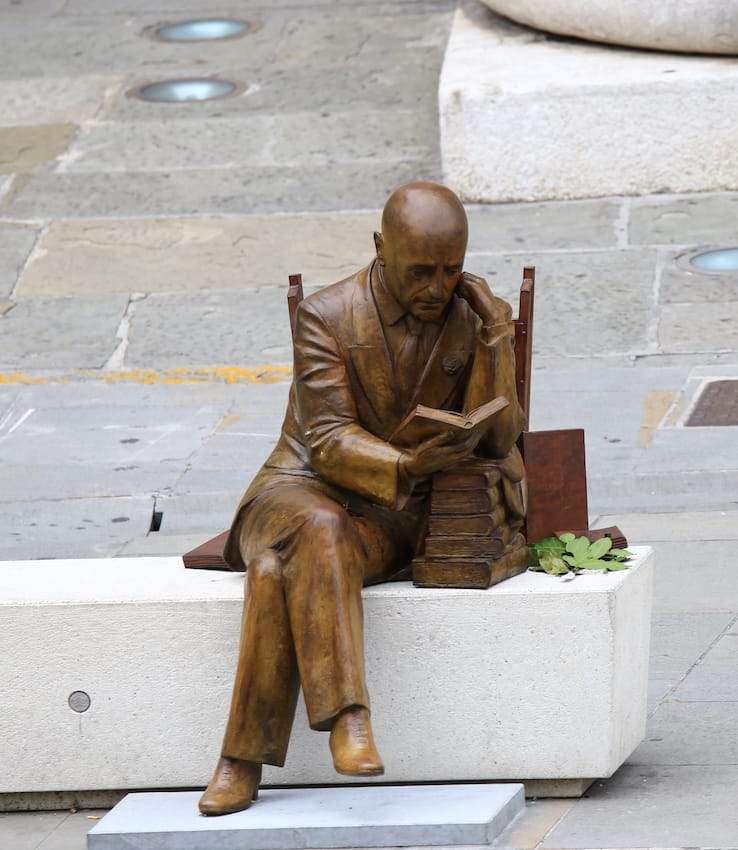 |
| Monument to Gabriele d’Annunzio (Trieste). |
4. The “Puppona” (Massa).
The palm for bad taste definitely goes to Massa’s “Puppona,” a sculpture known for the water gushing from the buxom woman’s zizzes to which the inhabitants have attached the evocative nickname. It is the work of a pride of the local sculptural school, Gigi Guadagnucci, who has left works of great delicacy and virtuosity (some of them collected in a museum that bears his name), but who evidently had raised his spirits a bit too high before waiting for this work, which, until a few months ago, stood on one of the busiest streets in the Apuan city’s historic center, and then was (fortunately) moved to a more defiladed location, in Rinchiostra Park. The pectoral fountain’s abnormal boobs have become so distinctive that virtually no one remembers what the work originally meant-we are among them.
 |
| La Puppona (Mass) |
5. Lambrusco Monument (Modena).
One of the greatest misfortunes for an artist is to find oneself in the center of a traffic circle: in recent years a traffic circle statuary has sprung up that has delivered us some of the most absurd monuments to be found on Italic soil, with the consequence that no artist in his right mind today would want to see one of his sculptures standing in the center of a traffic island. We have all come across hallucinatory statues: residents of Modena, for example, have for some years now seen on the outskirts of the city this giant grape cluster that would like to pay homage to the area’s wine production, as a tribute to lambrusco. To be appreciated is the naturalistic mimesis of the author, who has rendered the individual berries in different colors to indicate their different degree of ripeness: ingenious.
 |
| Lambrusco Monument (Modena) |
6. Monument to parmesan cheese (Bibbiano, Reggio Emilia)
When grillini and leghisti, a few months ago, repeated the leitmotiv “Talk to us about Bibbiano” to the PD, they were perhaps alluding to the vitupereous monument to Parmigiano Reggiano that decorates one of the traffic circles leading to the Emilian town: in fact, it is so ugly that it deserves a public debate, because thirty-two tons of Carrara marble cannot be wasted in this way. Especially if then, weathering accomplices, the grain of the parmesan cheese darkens over time and from a distance, rather than a wheel of cheese, it looks like a slice of badly cooked meat. Completing the triptych is a parmesan knife and what should be the wall of a dairy but looks like the side of a plastic fruit crate.
 |
| Monument to Parmesan cheese (Bibbiano, Reggio Emilia). |
7. Pesto Monument (Genoa, Italy)
Wanting to continue in the vein of food statuary, it is impossible not to devote a space to the giant mortar in Prà, the neighborhood of Genoa universally known as the land of real pesto and dop basil, to the point that someone had the bright idea of dedicating a monument to it, placed, needless to say, inside a road traffic circle. The author whose name we do not know (nor do we care to know) was evidently attracted by Giuseppe Penone’s research on the relationship between art and nature, because he thoughtfully arranged, inside the stone mortar, real basil plants. However, he must be told that that mortar, if it were real, would be unserviceable: from Luni to Ventimiglia everyone knows that the pestle must be made of wood, otherwise, in addition to the basil fragments, you risk eating those of the marble. The inscription “the land of basil” is the final gem: without it, there would have been a risk of missing this slight detail.
 |
| Pesto Monument (Genoa) |
8. Taggiasca olive monument (Taggia)
Another gastronomic specificity of Liguria is the Taggiasca olive, and could one not pay homage to it with an ugly monument? Obviously not, and so in Taggia they placed (again in the center of a traffic circle, in front of a gas station) two huge lotto number drawing compasses, which, however, are actually supposed to be stylized olives. The excellent idea of making the three olives out of wrought iron and leaving them to the elements has given way to rust, which has affected the monument, giving it a sympathetic reddish hue: but perhaps the author was a fan of Alberto Burri’s research on the subject and the interaction between work and atmosphere was intentional.
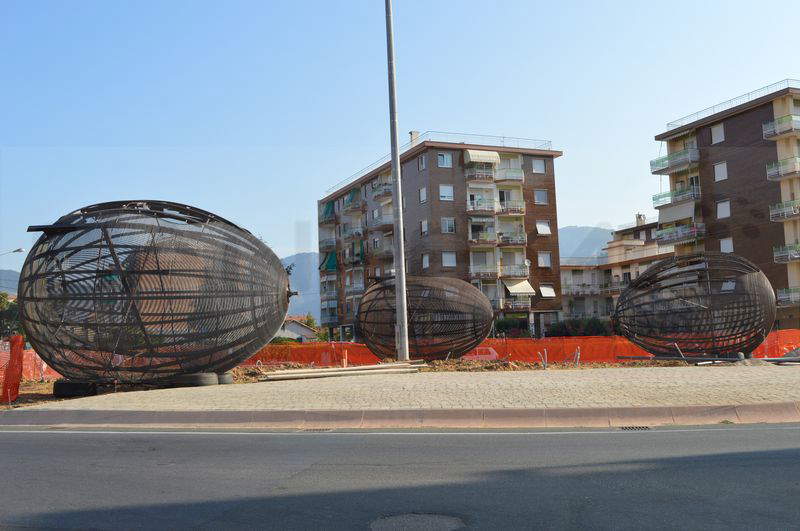 |
| Taggiasca Olive Monument (Taggia). |
9. Tuna Monument (Genoa)
This eye-catching monument probably dedicated to tuna fishing or at any rate to something to do with the well-known mackerel, for more than tuna they look like surfboards with improbable caps, has been renamed by the Genoese “monument to suicidal tuna” because of the unequivocal position of the unfortunate fish. It is located in the Molassana neighborhood, again inside a traffic circle, and we want to hope that the position of the tuna is due to their despair at their undeserved end.
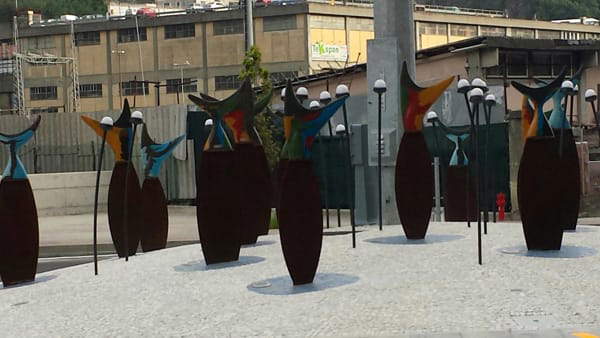 |
| Tuna Monument (Genoa) |
10. Shoe Monument (Vigonza, Padua)
If you’ve always wondered what would have sprung from Vladimir Tatlin’s imagination if the famous Russian constructivist had been in the throes of alcohol and acid delusions while also suffering torture, the answer is: the Shoe Monument in Vigonza, near Padua, a town known for its shoe-making activity. The tall structure towers unbalanced and claudicant amidst the Veneto countryside, amidst cottages and warehouses, with a spiral that wraps around three vertical pivots and ends with a red décolleté. The cases are twofold: either it is a joke the sculptor played on a city administration that was not particularly sympathetic to him, or in our art education system something was jammed when the author was a student.
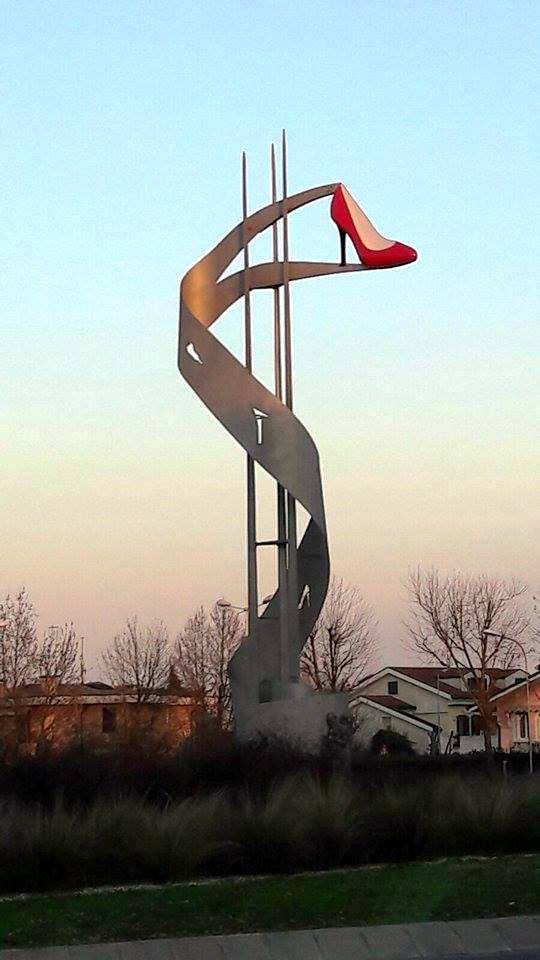 |
| Shoe Monument (Vigonza, Padua) |
11.Shoe Monument (Fossò, Venice)
It looks like the skeleton of a stegosaurus, but it is actually a stylization of another décolleté: it is clear that the artists have a deep dislike for this type of shoe. This kind of large deformed heater vaguely resembling a woman’s shoe is located at a traffic circle in Fossò, a town of seven thousand inhabitants in the province of Venice.
 |
| Shoe Monument (Fossò, Venice) |
12. The juggler (Carrara and Massa)
The two Apuan towns are separated by centuries-old parochialism, but they are united by this sculpture called “Juggler,” which, as you can plainly see, spins balls, and lots of them, and swirling. The one in Massa is in front of the wharf and is colorful, while the one in Carrara is silver: it used to be in front of the Teatro degli Animosi, then fortunately was moved to a less conspicuous location, inside a parking lot. To move the one in Massa and prevent the technicolor marbles from obscuring the view of the Apuan Alps from the sea, we will wait for an administration with more taste.
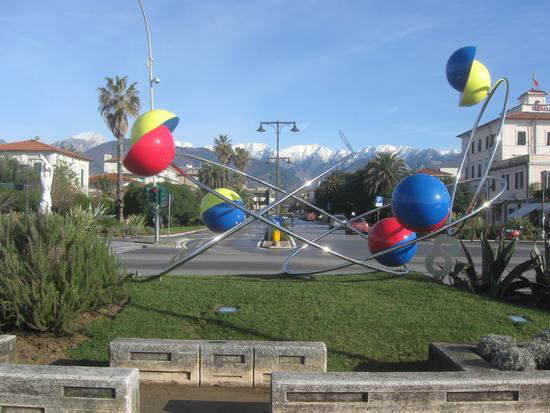 |
| The Juggler (Carrara and Massa) |
13. Monument to Bettino Craxi (Aulla, Massa-Carrara)
The province of Massa-Carrara, as it turns out, has a very particular feeling for ugly monuments. Not even one of the most talked-about public monuments of recent years (including nationally), Aulla’s Bettino Craxi statue, deviates from this. The inhabitants of the Lunigiana town have the grave fault of having chosen for themselves (and not even for a single term) a mayor who was a great fan of the socialist president, and who had the excellent thought of declaring his love with an atrocious monument that, despite several attempts to remove it and an attempt to sell it by a mayor who did not think the same way (it was valued at 150 thousand euros: not so much for the value of the sculpture, but for that of the valuable Apuan statuary marble sadly wasted to make it), is still there in its place. Unfortunately.
 |
| Monument to Bettino Craxi (Aulla, Massa-Carrara). |
14. Against the Wind (Forte dei Marmi, Lucca)
Let’s stay in the shadow of the Apuan Alps for another unlikely monument: it is located in the square situated in front of the pier in Forte dei Marmi, was created by a Czech sculptor (no, it is not what you think: Czech in the sense that she was born in Bohemia, although, given the result of the sculpture, the phonetics of the term could be misleading) and is called Controvento, but no one has ever understood what it represents. Basically, it is a naked bronze man with a golden veil that hides his head, wraps around his pyril and left calf, and then ends his run on a wheel that the figure is handling, while with his right foot he is probably trying to bring down the whole scaffolding of the contraption that stands on a horizontal pole. With his other foot, however, he is standing upright on a rugby ball cut in half. There is a similar one in Munich (evidently the mayor signed the resolution after a particularly merry evening at Oktoberfest), only the German colleague has pulled up his gold bandana to get a better look at the contraption he is fiddling with, whatever he is doing.
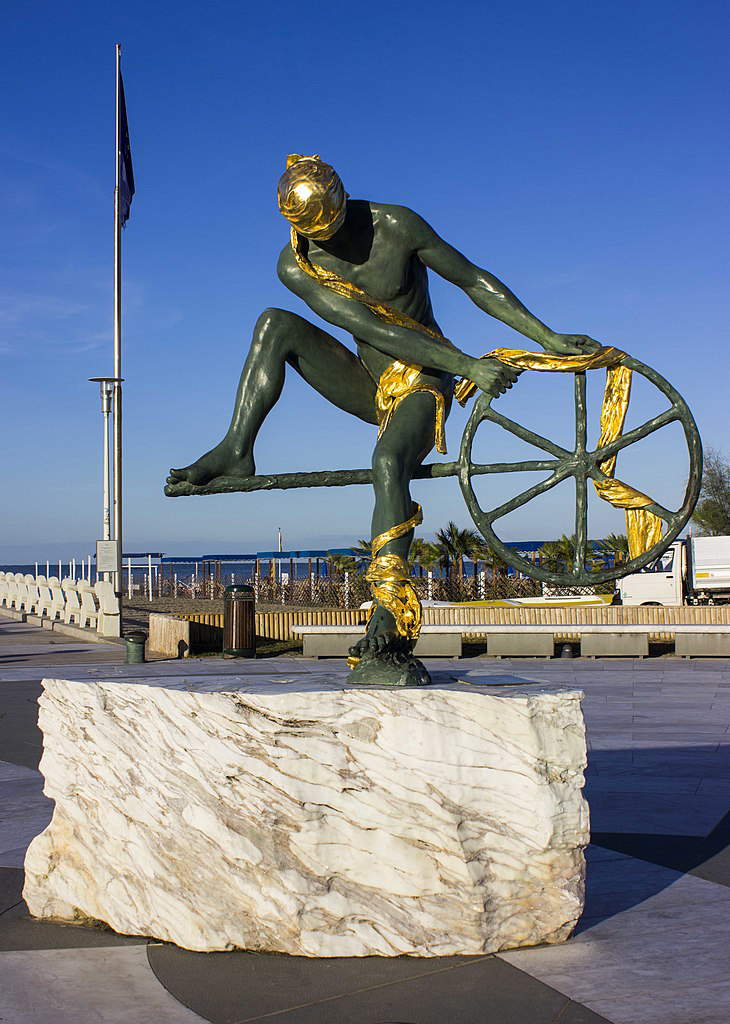 |
| Against the Wind (Forte dei Marmi, Lucca) |
15. The washerwoman (Bologna)
The porn washerwoman on Via della Grada in Bologna is one of the most touted monuments in the ugly statues rankings since she is doing her work in adamic robes and in an equivocal position: here we put a frontal image, but views from behind abound on the web that do not leave much room for imagination. Perhaps the sculptor wanted to shape an erotic fantasy of his own, or he wanted to start a new Youporn category, we don’t know. But now thank us because we have suggested a new role play for you to do with your partner.
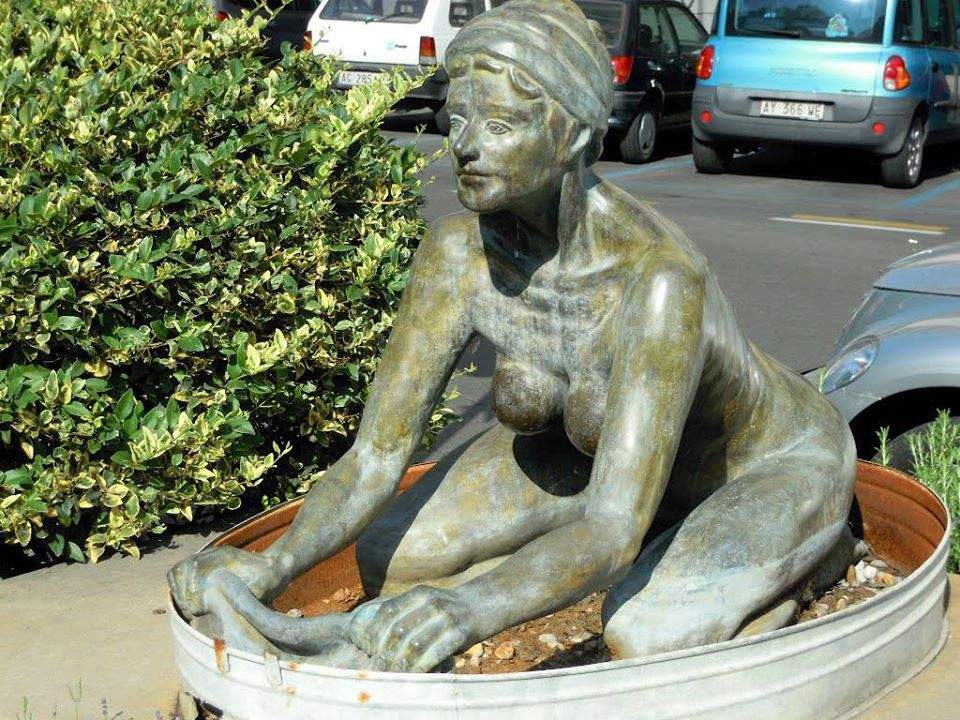 |
| The Washerwoman (Bologna) |
16. The truck driver (Bologna)
Bologna has given art history some of the greatest artists ever. Think of the whole school of the seventeenth century, with the Carraccis and Guido Reni, Francesco Francia, Donato Creti, Giuseppe Maria Crespi, and Amico Aspertini, all of whom can be admired in the museums, churches, and palaces of the historic center (after admiring the washerwoman mentioned above, of course). And then it is not explained why there are also such ugly monuments in the city. Deserving a special place on this list is the giant truck driver who may have misunderstood what his job consists of: he is the one who has to be transported by the truck, and not he who has to transport the vehicle. It has to be said, however, that the metallic truck driver (in the sense that he is transporting a vehicle) has something of a leggiardo in this delicate pose that makes him look almost like a ballet dancer, definitely appropriate to pay homage to truck drivers: because it certainly cannot be said that the sculptor wanted to pander to the collective imagination about the figure of the truck driver.
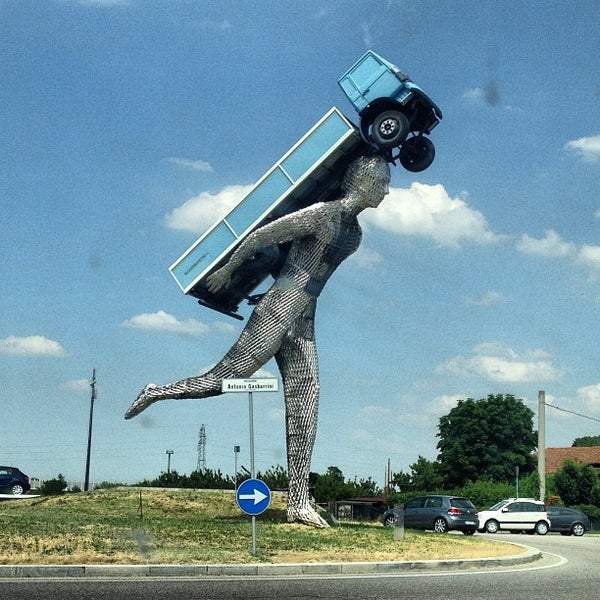 |
| The Truck Driver (Bologna) |
17. Romagna mia (Gatteo a Mare, Rimini)
Why be original when you can pander to the most trite stereotypes about your land? That must be what the Rimini administrators of Gatteo a Mare were thinking about when they wanted to place a monument to Secondo Casadei’s most famous hit in a traffic circle: so, if Romagna mia hadn’t already annoyed you too much in the musical version, if you happen to be in those parts you can hurt yourself even more with the monument version, which plays as much as the orchestra and the final verse of the refrain.
 |
| The Truck Driver (Bologna) |
18. The Little Horse (Cavallino, Lecce).
On the outskirts of Lecce there is a municipality of twelve thousand inhabitants called Cavallino, and it has rightly thought of self-homage with a monument depicting the eponymous animal: perhaps, however, the local administrators hate children or heart patients, since the huge beast looks like something out of a horror movie, and you might suffer a heart attack if you suddenly see it. As luck would have it, however, it is another example of the traffic circle bestiary: the colossal size of the disproportionate quadruped means that it can be seen even from a distance, and you can therefore prepare yourself beforehand so as not to arrive in front of it in shock.
 |
| The little horse (Cavallino, Lecce) |
19. Monument to Enrico Mattei (Bolzano)
When people think of the names of people who made Italy great, they usually think of epic monuments, depicting them in heroic, serious, or at least classical poses. In Bolzano, no. There, they think differently: perhaps, the huge lictor fasces of the Victory Arch are still too traumatic a sight, so in the South Tyrolean capital, monuments must necessarily be ridiculous to compensate for the uncomfortable ones of the past. That must be what the author of the statue of Enrico Mattei that the city has dedicated to the Eni founder thought: why pay homage to him with a traditional monument when you can remember that he loved to fish in the lakes of South Tyrol to depict him dressed as a fisherman, complete with fishing vest and fishing rod?
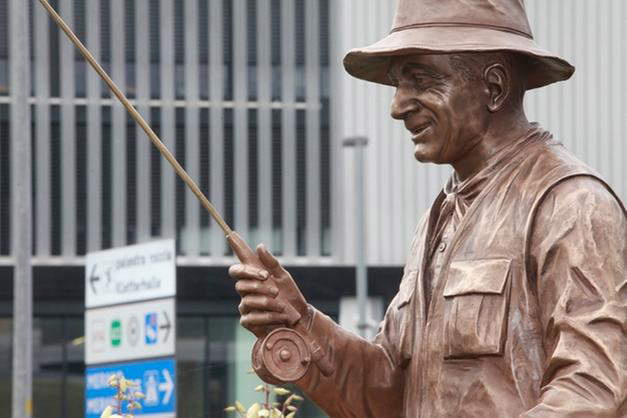 |
| Monument to Enrico Mattei (Bolzano) |
20. Monument to Pope John Paul II (Rome)
The undisputed king of ugly monuments is the pope-railroader, the John Paul II that has been greeting travelers passing through Rome’s Termini station for almost a decade (in fact, it was installed in 2011 and we still haven’t been able to get rid of it since). This huge seven-meter canopy with Wojtyla’s squarish, clumsy head on it, the work of Oliviero Rainaldi, has been juxtaposed over the years with a wide variety of objects: an umbrella, a bell, a rocket, a garret, Batman. But it is always waiting for someone to bring it closer to new meanings, if it really cannot be gotten out of the way.
 |
| Monument to Pope John Paul II (Rome) |
 |
| Speaking of monuments to be torn down: here are 20 of Italy's ugliest statues. What should we do with them? |
Warning: the translation into English of the original Italian article was created using automatic tools. We undertake to review all articles, but we do not guarantee the total absence of inaccuracies in the translation due to the program. You can find the original by clicking on the ITA button. If you find any mistake,please contact us.